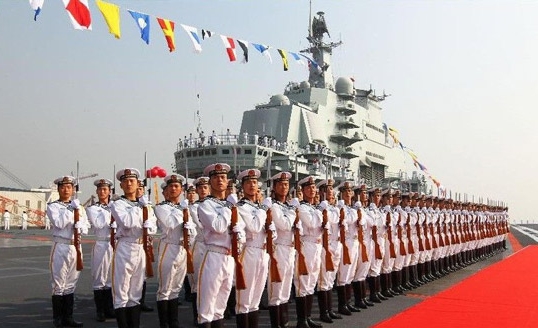
People's Liberation Army Navy
The aircraft carrier Liaoning and its escort ships - two Type 052C destroyers and a Type 054A frigate - are undergoing training in the South China Sea. Liaoning - unfinished Soviet Riga according to the project of 11436. Rice. Ministry of Defense of the People's Republic of China
The fleet of the People's Liberation Army is growing, and so is the number of ships. Their weapon systems are also being replaced, while revealing in which areas Chinese research centers and companies have problems with "overcoming" technical and technological barriers. The great-power aspirations of the naval forces of the Celestial Empire are too obvious, so let's look at their current state.
Budget, politics and numbers
2017 is another year of an increase in the defense budget of the People's Republic of China (PRC), this time by 7%. Officially, it is 1,3% of the gross domestic product (GDP), or about $150 billion. Officially, as well as unofficially, this amount may be several or several tens of billions of dollars more - according to estimates of various organizations involved in military spending. The Chinese People's Liberation Army Navy (MWCALW) is likely to benefit the most from this increase, as well as from subsequent ones. This type of armed forces is gradually becoming one of the main instruments of China's foreign policy. And this policy has already gone beyond the immediate vicinity of China and is increasingly boldly moving beyond the Southeast Asian region. It's no secret that the PRC is moving towards achieving the status of a maritime superpower, thereby challenging the United States. This will not happen in the next few years, also due to the significant remaining fiscal imbalance. Even taking into account unofficial estimates of Chinese spending on the military, it is easy to see that they are about 1/3 of the amount of the United States ($600 billion in 2017).
The increased budget for the naval forces should result not only in an increase in the number of ships, but also in the improvement of their capabilities and capabilities. The navy will also increase by about 15% and is currently estimated at about 235 20 people. soldiers. These changes should coincide with a reduction in the number of soldiers in the ground forces, which will likely lead to the transfer of part of their units under the command of the MWCALW. In terms of numbers, the Marines will benefit the most, and their status will quadruple. At present, this formation has 100 thousand people. soldiers, and in the end there will be 6, and will consist of 300 brigades. It is worth noting that the increase in the number of MWCALW soldiers will occur despite the announced reduction in the total strength of the Chinese armed forces by about XNUMX XNUMX people. But it is the MWCALW and its Marines that are expected to play an important role in protecting China's national interests. And not only in the area of potential conflict with the Republic of China (Taiwan), or in the area of the Korean Peninsula. The South China Sea, where China is systematically building up its political and military potential, appears to be an exemplary area for conducting operations with the use of the navy and marines. They are expanding, and in the literal sense, because the basis of the Chinese presence in this region is artificially enlarged islands. They create installations that include not only radar and reconnaissance systems, but also anti-aircraft and anti-ship missile systems. The development of the islands, their protection and defense requires the presence of naval forces. China's interests require the presence of the country's armed forces in sea lanes as well. Djibouti on the Gulf of Aden and the Bab el-Mandab Strait and the Pakistani port of Gwadar are likely to become the permanent deployment of the Marine Corps.
The South China Sea, which is adjacent to most of the waters of the PRC, is an area threatened by the outbreak of armed conflict. It is not only the interests of the PRC and the countries bordering this sea that clash here. The US and its allies play an important role in this region. With China increasingly involved in seeking to strengthen ties and establish cooperation with individual countries in Southeast Asia, the US position seems to be weakening. It is possible that the US position on more active participation in this region will change after Donald Trump comes to power. China's policy is characterized above all by its long-term and multifaceted impact. Their goal is not only to expand their own presence in the region, but also to strengthen political and economic influence,
as well as the military. As part of the activities of the naval forces of the PRC, it uses not only the South Navy, but also the border and fishing fleet. The latter were organized into something like a volunteer militia, whose main task is to collect and transmit information about the situation at sea. However, sometimes fishing boats are used for activities that, in the case of the boats, could lead to diplomatic consequences.

